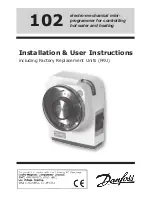
16
9. ADJUSTMENT OF THE ACTUATOR WITH A FITTING
After placing the actuator on the fitting and checking its attachment, the following adjusting procedure should be used:
1) Bring the actuator into an intermediate position by the hand.
2)
Connect the actuator to the AC mains and check the correct sense of output shaft rotation by starting the actuator
midway between the dead points of the working stroke for a short time. When viewing into the control box,
the output shaft should rotate clockwise in the CLOSE direction.
3)
Move the actuator electrically near the CLOSE position and complete the adjusting operation by settingthe actuator
precisely to the CLOSE position, employing the handwheel. In this position, set the position-limit switching unit (CLOSE
position-limit microswitch PZ) and the resistance or current transmitter, accordingto Points 5e and 5d, respectively.
4)
Bring the output shaft into the position in which the CLOSE signalling switch (SZ) should change over. Adjustment
of the CLOSE signalling switch (SZ) should be made, according to Point 5b.
5)
Move the output shaft of the actuator by the required number of revolutions and set the OPEN position-limit switch
(PO) and the resistance transmitter, according to Point 5e and 5d, respectively. The position-limit and signalling
switches as well as the position transmitter should be checked repeatedly.
6)
Bring the output shaft into the position in which the OPEN signalling switch (SO) should change over. Adjust
the OPEN signalling switches (SO), according to Point 5b.
Caution!
The cover of the control box should be removed so that it is displaced in the direction of extended axis of the output
shaft of the actuator, taking care to avoid any damage to the position indicator. When mounting the fitting on
the pipeline, the fitting should be brought into the midway position by means of the handwheel. By starting the electric
motor for a short time, check that the actuator rotates in the correct direction. If this is not the case, the two phase
conductors should be mutually reversed on the terminal board.
10. OPERATION AND MAINTENANCE
Depending on the operating conditions, the operation of rotary actuators usually involves only the transmission of
pulses, as required for the individual functions. In the event of a power supply failure, readjust the controlled device by
the handwheel. If the actuator has been connected in the circuit of automatic equipment (which does not imply
the control mode) it is advisable that manual remote control units are connected in the circuit so that the actuator can
be controlled even if a failure of the automatic equipment occurs.
It is the operator’s duty to ensure that the actuator is given the prescribed maintenance attention and is protected
against the harmful effects of ambient and climatic conditions not included in the Clause „ Operating conditions“.
Within half a year at the latest from putting the actuator into operation and then at least once a year, it is necessary to
properly tighten the bolts connecting the valve with the actuator. The bolts are to be tightened in a cross-wise manner.
Lubrication
The actuators are lubricated with plastic consistent lubricants or gearbox oil PP80.
Actuators with plastic lubricant
The types of lubricant and amounts are listed in the table.
Lubricants in the drive units supplied are designed to last the entire useful life of the unit.
During the time when the drive units are in use, it is not necessary to change or monitor the amount
of the lubricant.
The actuators with plastic lubricant are labelled
„Filled: solid grease“
on the power box at the side of
the hand-wheel.
Note:
The Ciatim 221 lubricant is designed for the friction points of rubber bushings against metal surfaces, roller
brake, the hub of an outer cogged wheel of a planetary-gear differential (for locations of friction between the shaft
and other surfaces).
52 030
0,30
52 031, 52 032
0,50
52 033, 52 034
0,70
Type number
of drive unit
Amount of lubricant
(kg)
T1
(-25 – +70 °C)
CIATIM – 201 GOST 6267-74
CIATIM – 221 GOST 9433-80
CIATIM – 221
GOST 9433-80
U1
(-40 – +55 °C)
UCHL1
(-50 – +55 °C)
CHL1
(-60 – +40 °C)
Type of lubricant for specific climatic conditions and temperature
Summary of Contents for MODACT MON 100/130-100
Page 2: ......
















































